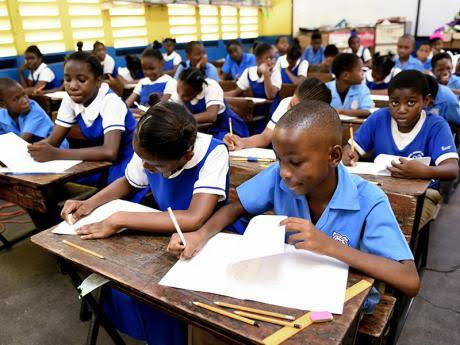July 5, 2004 brought to an end the impressive life of Jamaica’s third Prime Minister, Hugh Lawson Shearer. In the 13 days between his death and his funeral, Jamaica had the opportunity to reflect and assess not only Mr. Shearer himself but the kind of Jamaica over which he had presided.
The one word that resonated and echoed through the eulogies and remembrances that day was “decent.” Hugh Shearer, they said, was a decent man, and Jamaica had known a time of decency.
Mr. Shearer, who was Prime Minister from the death of Sir Donald Sangster in April 1967 to February 29, 1972, set the stage for the beginning of “The Seventies.” Up to the time Edward Seaga wrested the leadership of the Jamaica Labour Party from Mr. Shearer in 1974, the island had not had to deal with the conflagration and gun terror that marked the Jamaican civil war of 1976-1980 during which nearly 2,000 people were killed.
It was the second attempt to change the leadership after the February 29, 1972 election in which Mr. Shearer lost heavily to Michael Manley and the People’s National Party. The first, a year earlier, was staged at the Tower Isle Hotel where the Jamaica Labour Party (JLP) met to discuss the leadership question.
But when the agitators behind the expulsion move found that they could not get all the necessary backing, they quickly recanted and gave their fealty to Shearer. ‘We Back You Hugh’, was the Daily News headline on the story of the meeting the next day. But when they tried again in 1974, Mr. Shearer, displaying his decency and distaste for disorder, declared, “If dem want it dem can take it,” and threw in the towel.
Much to the chagrin of Housing Minister David C. Tavares and others in the JLP top leadership, Shearer had won the leadership by one vote following the death from an aneurism in a Montreal neurological hospital of Prime Minister Sangster on April 11, 1967.
Shearer was sworn in as Prime Minister by Governor-General Clifford Campbell four hours after Sangster died. But he never wore well the rough and tumble of intra-party squabbles.
Indeed, with all kinds of rumours circling about Sangster’s “real” cause of death and the mysterious death previously of Portland-based JLP Minister Ken Jones at a Montego Bay hotel (Sunset Lodge) where the JLP had been meeting in retreat, Shearer was reported to be taking every precaution about where and what and from whom he ate and drank.
Shearer’s short time as Prime Minister (1967-1972) is regarded by many economists as covering some of Jamaica’s most productive years. For the entire five-year period, gross domestic product grew every year between 1967 and 1971, from $528.9 million in 1967 to $722 million in 1971.
But there were also scandals and intrigue, accompanied by unceasing attempts to take over the party from him. And fate, in the person of Walter Rodney, intervened and set the stage for the PNP.
Shearer was appointed Prime Minister just a few weeks before his 44th birthday. At age 43 he had become Jamaica’s first Black Prime Minister. But he gave no recognition to that title. Instead of “First Black Prime Minister”, and in the face of rising popular discontent, some of which was a spill-over from the insurgent Black Power and Civil Rights movements in the United States, Shearer projected himself as “The No-Nonsense Prime Minister”.
What we did not know then was the extent to which this was a warning to his own colleagues as well as to the populace in general.
Shearer had inherited a Cabinet appointed by Sangster only five weeks before and he reappointed them all. For his Finance Minister he named Edward Seaga, and named himself to the post of Minister of Defence, which had been Sangster’s. He also kept the post of Minister of External Affairs to which Sangster had appointed him.
Mr. Shearer had a special interest in education, and courtesy of the Canadian International Development Agency (CIDA) he was able to make marked improvements to the existing system under the New Deal Education Programme. The New Deal Programme was designed to provide a sound education for every child in Jamaica, and, for the first time, the prospect of a totally educated population became a real possibility.
The other visible change was the number of students entering and graduating from high schools, although this was a legacy from the Norman Manley PNP Government of 1955 to 1962. Nevertheless, Shearer also made his own impact on education. Under him, free tuition at technical high schools was started as well as free tuition at secondary schools for children of paupers.
In Foreign Affairs, he gained concession for a managed market for Caribbean bananas through shrewd bargaining at the Commonwealth Conference in Zambia, when the future of that organization hung in the balance.
Foreign Affairs was the position in which he felt most comfortable throughout his career. He was an articulate opponent of the apartheid regimes of South Africa and Rhodesia. He worked closely with Robert Lightbourne in the months of discussion in Geneva, Switzerland, to obtain an International Sugar Agreement in 1970.
He greeted the rising tide of crime with a forthright directive to the police:
“When it comes to handling crime in this country, I do not expect any policeman, when he tackles a criminal, to recite any beatitude to him (applause) … with due respect to the ‘ologists, the police cannot tackle a wrongdoer and talk about blessed are the meek.”
Nevertheless, despite Shearer’s successes, personal decorum, civility and distaste for barbarism, his government quickly ran into difficulties and opposition from those who held freedom and civil liberties dear. It became, in many ways, a heavy-handed, restrictive and suppressive regime. Passports were seized, travel and books were banned, so too was radio air play for popular songs.
There were also attacks on the freedom of the press. The most notorious of these related to radio station RJR (Radio Jamaica and Rediffusion). It’s new and only competitor, the Jamaica Broadcasting Corporation (JBC), was owned by the Government and was, to everyone’s distress, being openly controlled by the Government. In practice this meant that expressions of dissent were not aired by JBC. Indeed, in at least one infamous incident, Wilmot Perkins, a senior journalist, was fired from the JBC the very next morning after he interviewed the Minister of Home Affairs, Roy McNeil, and had asked questions in the interview that did not sit well with the Minister under whose portfolio the radio station operated.
It was a time when the popular Sunday afternoon activity was to listen to “political broadcasts” on radio. Air time was purchased by the political parties to have their members speak to the public on topics of interest. So insecure was the Shearer regime at this point that the JBC was, more often than not, refusing to air broadcasts from the Opposition PNP members.
The private station, RJR, on the other hand, kept itself open to all kinds of expression and welcomed the “political broadcasts”. In short order, two things then happened. Instead of being required to have its licence renewed every five years, RJR soon found it had to present an application for renewal every year. Then, in a blatant application of prior censorship, a civil servant, Horsford Scott, was placed in the Prime Minister’s Office to read and approve scripts submitted to the radio stations for (political) broadcasts before they were aired.
It was in this repressive climate that the Shearer regime got its most frightening test. In 1965, West Indian students at Carleton University in Ottawa, led by Jamaicans Barry Myers and Anthony Hill who was later to become head of Jamaican foreign missions (Ottawa and Geneva), organized the first Conference on West Indian Affairs at a university in Montreal along with colleagues in Montreal. With a feature lecture by the Barbadian author George Lamming, and students expressing themselves freely on the West Indian condition, the conference was a resounding success. It was repeated in the following two years, again in Montreal.
In 1968, with a new set of students and with the US civil rights movement reverberating everywhere, it reconvened as The Black Writers’ Conference. Guyanese scholar and intellectual Walter Rodney, who had a brilliant scholastic tenure at the University of the West Indies, Mona in Jamaica, and who was now a lecturer there, flew to Montreal to participate in the conference.
It was then that the Shearer regime struck. Rodney, a persuasive and articulate speaker who had also devoted himself to groundings with ordinary Jamaicans, returned to Jamaica from the conference only to discover that he had been declared persona non grata and barred from landing for reasons that were not immediately clear. Later it would be said that he had been followed and watched by the security services and that he was certainly a subversive figure.
The result of this action could not have been anticipated by the Government. The university students left the Mona campus and took to the streets, marching all over Kingston, through Cross Roads where one student, in the exhilaration of the moment, drove away a JOS bus, The students marched as far as to the Gleaner offices on Harbour Street where they demonstrated noisily against the Government. Unhappily, they were joined by rebel elements that damaged property including several buses – not to mention the students’ cause. People were killed and there was extensive damage of property.
It was the fall of 1968 and it very much was a herald of the fall of the Shearer Government which was just a year and a half old. Prime Minister Shearer called in a number of people for briefings at Jamaica House. One was Sir Philip Sherlock, Vice-Chancellor of the university. One group was the Guyanese students at the university. Both Sherlock and the Guyanese students seemed to have accepted whatever it was Shearer told them.
He also called in the Gleaner’s editor. A shaken Theodore Sealy returned from the briefing to his editor’s chair at the Gleaner and delivered in the following days two urgent, frightened and frightening editorials entitled, “To Sentry”, and “Cave Mona.” The editorials condemned the students out of hand, the country was called to look out carefully for signs of insurrection, and warned that it would now have to pay plenty money to watch for attempts at subversion.
And yet, while all these issues might have strengthened the feeling among Shearer’s peers that they could be better leaders than him, it was internal struggles among them that shattered whatever unity there might have been in the party that William Alexander Bustamante had gathered around him in 1943, and it was these wranglings that now spelled electoral doom.
Next issue …Part 2



